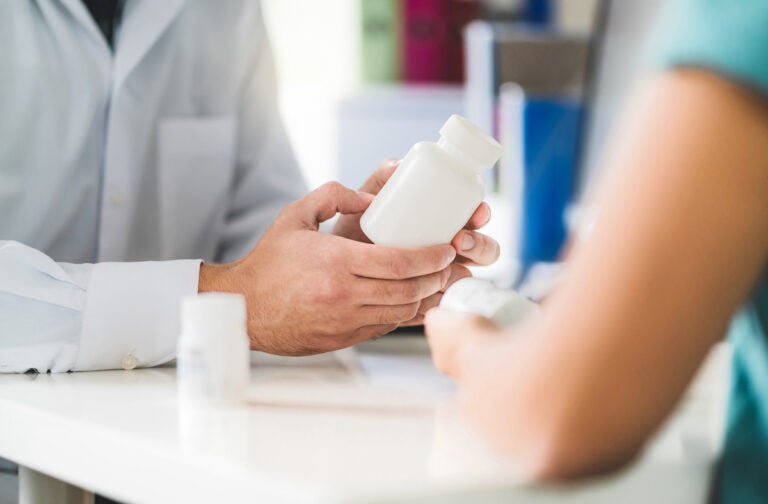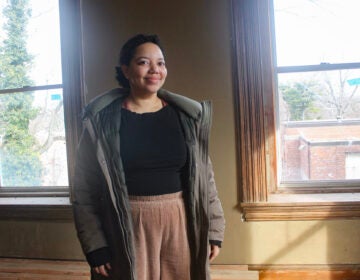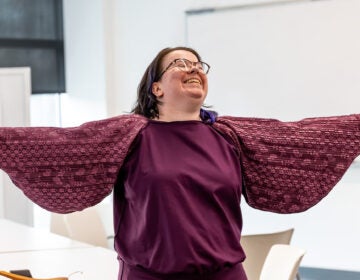A neurologist took DIY treatments seriously. Has it sparked a breakthrough?
Rick Bedlack leads two programs dedicated to solving the mysteries of ALS.
Listen 13:48
Doctor consulting patient about right medication. (Bigstock/TeroVesalainen)
This story is from The Pulse, a weekly health and science podcast.
Find it on Apple Podcasts, Spotify, or wherever you get your podcasts.
Curiosity has always been a driving force in neurologist Rick Bedlack’s life – noticing things and then trying to figure out how they work, or how they came to be.
Growing up, his fascinations – in the way someone shuffled when they walked or why rolling down a hill made him feel dizzy – led him to jot down countless questions only local librarians could help him unravel.
But it wasn’t until his residency after medical school that he first saw a patient with Amyotrophic lateral sclerosis or ALS, a rare and fatal neurodegenerative disease.
The encounter introduced him to mysteries he would dedicate his entire career to.
“It was the most dramatic example of this connection between a nervous system that’s on fire and what somebody looks like in clinic,” said Bedlack. “Somebody with epilepsy, when they’re having a seizure, it’s traumatic. But when they’re in clinic, they look perfectly fine. There’s nothing really to see about their exam most of the time. But here’s a person with ALS and they have muscles that are shriveled up and they’re twitching and they’re weak and their reflexes are off-the-chart increased. So it was like, ‘Holy cow, I’ve never heard a story like this. I’ve never seen an exam like this.’”
Then his attending physician walked into the room and addressed the patient.
‘[He] said, ‘This is what it’s called. We don’t know why it happens and there’s nothing we can do about it. Just go home and get your affairs in order.’ And I drove home that day and I said, ‘I think this is going to be the disease for me’ because it’s fascinating.”
Of course, Bedlack knew ALS wasn’t just some mystery to crack. It was a death sentence for tens of thousands of Americans. And given the severity, this seemed like a way to put his natural curiosity to good use. To find what causes this unrelenting disease and maybe find ways to reverse it.
“There’s not really a lot of options or a lot of hope for people. And so what an opportunity for someone like me to build a program that gives people those things,” said Bedlack.
Untangling ALS
Bedlack went on to become Duke University School of Medicine’s first endowed professor of ALS. And because many of the answers he was looking for about the disease couldn’t be found in books, he began to consult more intensely with his patients, treating them more like colleagues than cases. He’s attended more archery events, golf and poker tournaments than he can count.
And in doing so, he was surprised to learn just how many of his new patient-partners weren’t waiting around for doctors and researchers to save them.
“Nobody ever taught me in neurology how common it was for people to walk away from clinic and to reach out to what I call this space of alternative and off label treatments,” said Bedlack. “But it was clear in the first few years that most of my patients were coming in with bags full of stuff that they had purchased.”
Subscribe to The Pulse
Vitamins, unapproved serums in glass vials, even acupuncture programs. His patients slowly opened up to Bedlack about dozens of supposedly effective elixirs and therapies touted on sketchy websites or anonymous forums that they were trying. The kind of “treatments” that were easy for physicians to dismiss or ignore.
“Really they weren’t even being recorded, much less talked about like they weren’t getting into any medical records at the time,” said Bedlack. “When people were checking in, nurses were only interested in medicines. They weren’t interested in vitamins and supplements and products that maybe couldn’t even be characterized. So, one day I asked, ‘What is all this stuff?’ and somebody said, ‘well, I figured you probably wouldn’t want to talk about this.’ And then, the more I thought about it, I said, ‘Wow, if this is a common thing that people are doing this, shouldn’t I be interested?’”
His patients simply didn’t have time to wait on the conclusions of lengthy clinical trials that might never come for these products and programs. If they were looking elsewhere for answers, Bedlack felt he had a responsibility to weigh in on what they were trying rather than dismiss it all off-hand.
“Shouldn’t I want to partner with patients using my years of training to try to help them make more informed decisions about these?” said Bedlack.
Many of his colleagues in medicine disagreed.
“The majority of my peers said, ‘this is a terrible idea because all you’re going to do is lend some legitimacy to some of these strange products and websites that are out there. They’re going to say, you know, this product is under investigation by Dr. Bedlack at Duke and this team of respected scientists,’ and they’re right.” said Bedlack.
But he thought the potential good outweighed the risks.
“I just feel like you have to put it all together and ask yourself: ‘How does it all shake out?’” To me, the need for this in the patient community, the desire for it, far outweighs any of that criticism that I got in the beginning.”
In 2009, Bedlack connected a cohort of like-minded researchers to create ALSUntangled — a group dedicated to investigating alleged or emerging ALS treatments that spring up online.
“What if we work together,? What if we crowdsource this? Like, built a team of clinicians and scientists who were interested in doing this together.”
Together, they dug into one of the group’s first product reviews: Iplex, a drug that contained a man-made insulin-like growth factor whose dysregulation has long been thought to be involved in ALS. ALSUntangled concluded that data from a seemingly promising Italian study lacked a control group and was potentially tainted with selection bias.
“The problem with that is the time that it takes to really investigate one thing. It takes a while,” Bedlack said. “I’ve found that it takes about 40 hours to do a really good investigation of just one product. And, nobody has time, if there’s hundreds of these things out there, which there are, nobody has time to do them all.”
Since that first review, the ALSUntangled team has grown to over 130 researchers across 11 countries.
“Since 2009, there hasn’t been a single day that I haven’t at some point been working on a review of a product that a patient asked about,” said Bedlack.
ALSUntangled has reviewed dozens of products and therapies – keeping the information up to date whenever new evidence becomes available.
Most have been relatively unremarkable, some pretty dangerous. But a minority have actually shown real promise.
The work has given Bedlack and his team permission to wander down strange paths, just to see where they might lead. And now one of the strangest of paths of them all may finally be paying off.
The energy healer
Two years after publishing that first ALSUntangled review, Bedlack stumbled across yet another seemingly unreliable internet rumor related to ALS.
“I came across a video of a woman from Virginia who said that she had ALS, that it was rapidly progressing, that she had lost almost all of her function.”
Her name is Nelda Buss – a mother of two whose ALS journey began in the mid-80s, when she told her primary care doctor about some foreboding, mysterious symptoms she was experiencing.
“It started with my weak hands,” said Buss. “And then my legs sort of were getting weak. I fell a couple of times. I went back to him and he said, ‘Well, I’ll make the neurology appointment like in January.’”
Buss believed her doctor didn’t want to be the one to give her the bad news. She was officially diagnosed with ALS when she was 47. By then she was having difficulty walking.
“My husband got up, came up and picked me up. And I think we cried all the way home.”
Buss consulted with ALS experts – some of the best in the business at the time, according to Rick Bedlack. But she just kept getting worse.
“I was diagnosed in January and by July I was in a wheelchair,” said Buss.
Desperate, she sought help from Dean Kraft, a man from New York City who claimed to be an “energy healer”. She had heard about him from a magazine article.
“The first time I went to him he gave me the first treatment and my diaphragm was beginning to weaken and I couldn’t breathe as well as I could before,” Buss told the hosts of the daytime talk show The View back in 1998. “And I noticed I could cough and blow my nose better.”
Every other week for over a year, Buss and her husband would drive up to New York City from their home in Virginia, where she was carried into Dean Kraft’s small office. Kraft would place his hands above Buss’ head and claim to release healing energy.
“He would work like two hours on Saturday on me and two hours on Sunday.” said Buss.
In total, Buss said she paid Kraft about $25,000 for these sessions.
“He said, ‘you just can’t always believe the doctors,’” said Buss.
“The first time I went to him he gave me the first treatment and my diaphragm was beginning to weaken and I couldn’t breathe as well as I could before,” Buss told the hosts of the daytime talk show The View back in 1998. “And I noticed I could cough and blow my nose better.”
Every other week for over a year, Buss and her husband would drive up to New York City from their home in Virginia, where she was carried into Dean Kraft’s small office. Kraft would place his hands above Buss’ head and claim to release healing energy.
“He would work like two hours on Saturday on me and two hours on Sunday.” said Buss.
In total, Buss said she paid Kraft about $25,000 for these sessions.
“He said, ‘you just can’t always believe the doctors,’” said Buss.
Dean Kraft died in 2013 of a massive heart attack. He was 63. Kraft was also featured in the same segment from the View and other videos about Buss’ story.
“I don’t require people to believe in religion,” he told the hosts. “They don’t even have to believe in me. I just lay my hands on them and fortunately the majority of people get well.”
And after a couple of years, Buss said that’s what happened to her.
“I had a walking party at the Marriott hotel and invited all our friends, so I had Dean come to the party. So they came down from New York and he wanted me to dance with him.”
Rick Bedlack was shocked when he came across the story of Nelda Buss.
“She completely recovered and in fact the video was pretty convincing,” said Bedlack.
Again, the doctor’s curiosity kicked in. He contacted Buss and asked if she would give permission for her doctors to send Bedlack her medical records.
She obliged.
“By the time I finished those, I was absolutely convinced that she really did have ALS, that she progressed to where she was nearly dead, and then she made a full recovery over the next two years under the care of this energy healer,” said Bedlack. “What I wasn’t convinced of is that it was the energy healing that made her better, in part because it had no plausible mechanism. Like, there is no known biological mechanism where a person can have energy come out of their hands that heals the body dying motor neurons. And so I didn’t understand that part.”
Bedlack reached out to Kraft to try to organize a study of his methods.
“[I] said,’I don’t know how it is that this happened, but I’d like to do a small study of your technique and about 10 more patients.’ And I’ll never forget his response. He said, ‘Richard, for those who believe no more proof is necessary. And for those who don’t, no proof is ever going to be enough.’ And that’s the last I ever heard of him.”
‘How are we not studying these people?’
But the story started a conversation within ALSUntangled about other inexplicable disease reversals his fellow researchers had seen.
“They said, ‘did you know these kinds of cases have actually been reported in the literature since the 1960s?’ And in fact, many of the people on the ALSUntangled team had said, ‘well, you know, I saw somebody that I thought had ALS and they progressed for a while and then they recovered.’”
His colleagues said they just thought those patients had been misdiagnosed — that they didn’t really have ALS. But for Bedlack, this was a light bulb moment.
“And I was like, ‘Wait a second. How are we not studying these people? How many of them are there?’ I mean, there’s a precedent for studying people who are unexpectedly resistant to diseases and finding pathways that have never been manipulated and finding treatments to manipulate those pathways that wind up helping everyone.” said Bedlack.
So Bedlack started yet another program to study these reversal cases. He began digging out medical records, sending out questionnaires, and trying to find commonalities.
“Suddenly I’m in a whole other direction for the past 12, 13 years, this whole ALS reversals research. But I have to say that’s also gotten quite interesting.”
Bedlack said they have identified 61 ALS reversals and have genetically investigated 22 of those. And just last year, his searching spawned a breakthrough.
“We actually found a target,” said Bedlack. “About a third of these patients appear to have a genetic abnormality that’s very, very rare in people with typically progressive ALS. I think that’s the most likely explanation for at least a third of these ALS reversals. And we are now doing a much larger study to see in a huge population of people with ALS: is there a relationship? If there is a relationship, I will be dropping just about everything and engaging in a clinical trial. But again, here I am in a space in a direction that I never thought I would be.”
Nelda Buss is now 82 years old and she still believes Dean Kraft saved her life. But she remains open to other explanations, assuming Rick Bedlack and his tireless team of researchers can find one.
Editor’s note: This story has been updated to reflect that Rick Bedlack has identified 61 ALS reversals.
WHYY is your source for fact-based, in-depth journalism and information. As a nonprofit organization, we rely on financial support from readers like you. Please give today.







